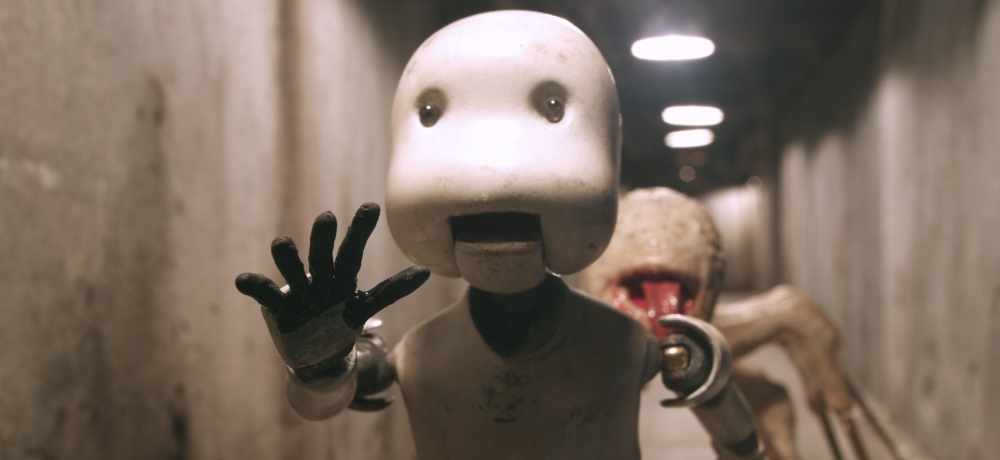


Guillermo del Toro once referred to a short film titled “Junk Head 1” as a “one-man band work of deranged brilliance” with “monumental will and imagination at work.” In 2017, after seven painstaking years, “Junk Head” was released as a feature and was a surprise hit at the Fantasia International Film Festival that year. Now, the film is being re-released with a new theatrical edit. An existential work both dark and humorous with a classic sci-fi atmosphere, first-time director Takahide Hori’s stop-motion epic is a cult classic in the making.
Set in a post-apocalyptic Earth where mankind attains longevity through gene manipulation, humans are losing the ability to reproduce. And with a virus epidemic that has killed over 200 million people, they decide to descend below to an underworld dominated by artificial lifeforms known as Marigans. Created by humans as labor to develop this mysterious workers’ city, these beings have found fertility with a Tree of Life—Marigans born as its fruit. One human sets off on a mission to retrieve a biological sample in the hopes of studying their unique evolution to save humanity.
A film of expansive lore and landscape, the influences of films like Alien, Metropolis, and Star Wars are felt both in narrative and design as we discover this gritty, subterranean labyrinth of cement and machinery. The purpose of the Marigans’ creation is clear as a hammer on steel that dominates the introductory score, with the camera moving through this intricate miniature movie set that could be mistaken as live action. As our human on a mission descends in his pod, it’s blown to bits and he is injured with only his head remaining. Not the warmest of hellos, but a doctor brings him back to life with a body crafted from junk collected by three Jawa-like junk collectors. Losing all memory, our titular junk head no longer recognizes himself, looking at his hands in disbelief. While his design could be added to the “cutest movie robots” list alongside Wall-E and BB-8, it won’t be his only form as, while attempting to navigate this unfamiliar world, his curious nature gets him into some trouble. Coming across scary creatures, always one more frightening than the last, and some nefarious characters, his mission to save humanity and collect a genetic sample no longer seems to be of much importance as he goes through several C3PO-like deconstructions and reconstructions. He may regain his mind in his first form, but he loses his voice in the next.
When rebuilt for the second time, it is in the presence of the labor force in the underworld’s underbelly—the ones keeping this place alive with no real purpose. What’s fun here is the presence of muscular and intimidating women who whip the men into shape, diverting from the labor force depicted in Metropolis. It’s finally in this middle section where he is given the name “Junkers” and truly becomes a clog in this subterranean machine. Like the workers, Junkers is sent to do menial tasks. Their work is repetitive, with one worker who, for the past 400 years, has been tasked with keeping a flame alight. But while the flame keeps this machine burning, the one keeping the narrative burning peters out. The film starts to feel much longer than it is as the story gets a bit muddled, with the initial driving force of the narrative—Junkers getting a genetic sample from a specific Madrigan—getting lost. The film also distracts itself with the backstory of a very minor character. But just as the initial intrigue and wonder feels to be wearing off, Hori surprises with some fast-paced action. You can’t help but wonder how difficult it must have been to craft the stunts executed here as these dolls are made to jump, kick, and slide in slow motion while firing weapons. It’s a scene that no doubt is one of the best fight sequences in an animated film.
Junk Head is awe-inspiring. It may not reach the level of masterwork in terms of narrative, but it’s stop-motion mastery. It’s a bloody adventure that leans more into tragedy in many ways, as there never seems to be a light coming at the end of the tunnel for Junkers. But after almost dying so many times, he says he feels more alive than ever. Through his journey, the film speaks on themes of humanity, friendship, identity, and the consequences of human activity. It’s a film with lessons we can all come away with and an appreciation for a style of animation that hopefully will never be thrown away.
Movie Score: 3.5/5
----------
Go here to catch up on all of our Fantasia 2021 coverage!